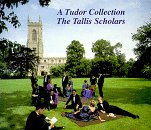Splendour in music
FrKurt Messick | Bloomington, IN USA | 09/08/2003
(5 out of 5 stars)
"--Music--
This collection consists of four CDs, each having a key composer at the center: William Cornysh (d. 1523), John Taverner (d. 1545), Thomas Tallis (d. 1585), and William Byrd (d. 1623). For collectors of Tallis Scholars music, this will be repeat performances -- the music contained here come from prior releases, brought together as a set piece to show the relationship between these important composers. All of the composers worked for either royalty or other leading persons of the period; like much of the rest of Tudor sensibilities, there is an ornate, almost over-the-top quality to many of the compositions represented here. While much of the music is liturgical, there are a few pieces scattered about that are more folk-tune or secular in nature.The Tudor period was one of fascinating history, and music certainly kept pace. One can almost envision the rivalry of Wolsey and Henry VIII in the compositions of Taverner (who worked for Wolsey) and Cornysh (who worked for Henry VIII, and prior to that, Henry VII). The development of the music over time, from Cornysh to Taverner to Tallis to Byrd can be heard, which makes perfect sense given the historical development of the personalities involved (Byrd was a successor to Tallis, who was a successor to Cornysh, in the same position in the Chapels Royal).One of the difficulties of the increasingly florid, ornamented style of music is the lack of clarity of the language. Early polyphonic chant is fairly easy to understand; by the time of the Tudors, it is sometimes impossible to recognise the words being sung without the lyrics being provided in writing. The Reformation brought back a clarity and simplicity, which Tallis and Byrd adopted during the reign of Elizabeth to bring great effect to the combination of music and meaning. Byrd, of course, remained a Roman Catholic, and wrote his famous Masses at a time when they would not have been permitted to be performed in churches and official liturgical settings; as such, they possess a power of mystery and longing. They provide both an encapsulation and conclusion to the Tudor era of composition.All of these pieces are glorious polyphonic compositions of extraordinary power and grace. Taken as a set, they make a wonderful snapshot of Roman Catholic/proto-Anglican music during the Tudor period. All subsequent liturgical music in the English church can trace its origin to this time; either in development from or in reaction to the standards developed during this time, this is a pivotal age for such music.--The Tallis Scholars--
The Tallis Scholars are a group dedicated to the performance and preservation of the best of this type of music. A choral group of exceptional ability, I have been privileged to see them many times in public, and at almost every performance, their music is brilliant and the performance is delivered with near-flawless grace. Directed by Peter Phillips, the group consists of a small number of male and female singers who have trained themselves well to their task.This is a truly wonderful collection."


 Track Listings (9) - Disc #1
Track Listings (9) - Disc #1